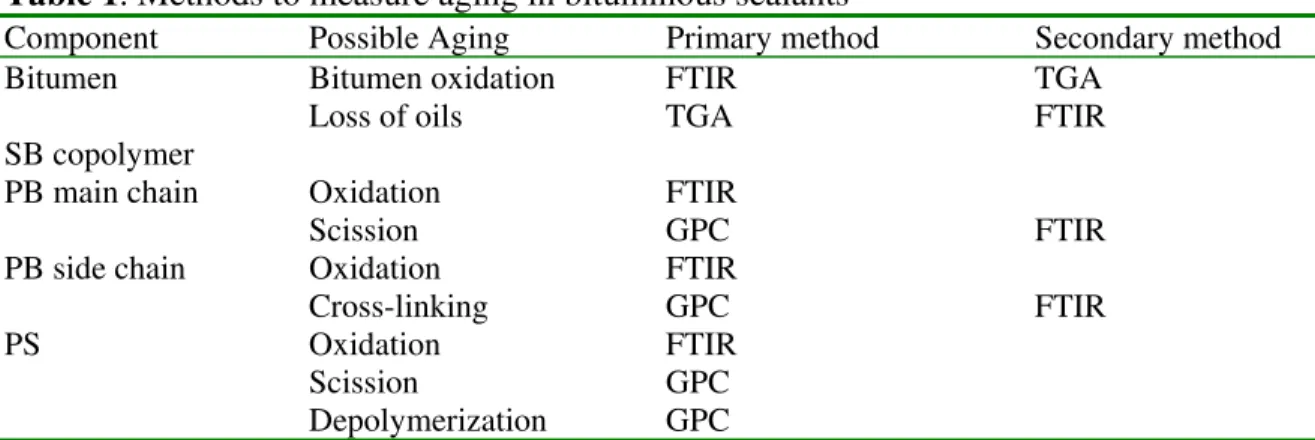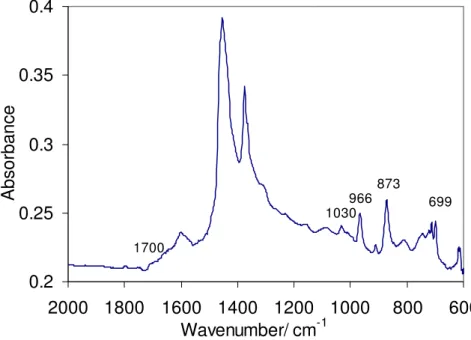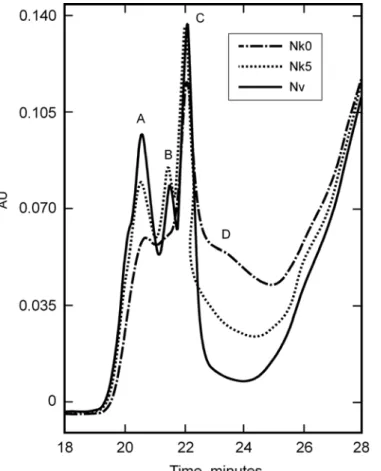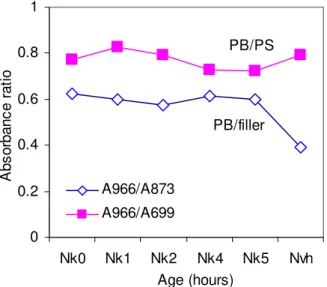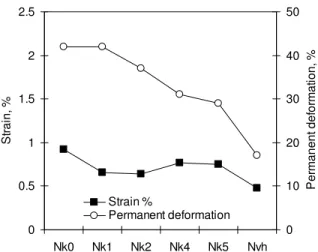Publisher’s version / Version de l'éditeur:
Transportation Research Record, 1991, pp. 119-123, 2007-10-01
READ THESE TERMS AND CONDITIONS CAREFULLY BEFORE USING THIS WEBSITE.
https://nrc-publications.canada.ca/eng/copyright
Vous avez des questions? Nous pouvons vous aider. Pour communiquer directement avec un auteur, consultez la
première page de la revue dans laquelle son article a été publié afin de trouver ses coordonnées. Si vous n’arrivez pas à les repérer, communiquez avec nous à PublicationsArchive-ArchivesPublications@nrc-cnrc.gc.ca.
Questions? Contact the NRC Publications Archive team at
PublicationsArchive-ArchivesPublications@nrc-cnrc.gc.ca. If you wish to email the authors directly, please see the first page of the publication for their contact information.
Archives des publications du CNRC
This publication could be one of several versions: author’s original, accepted manuscript or the publisher’s version. / La version de cette publication peut être l’une des suivantes : la version prépublication de l’auteur, la version acceptée du manuscrit ou la version de l’éditeur.
For the publisher’s version, please access the DOI link below./ Pour consulter la version de l’éditeur, utilisez le lien DOI ci-dessous.
https://doi.org/10.3141/1991-14
Access and use of this website and the material on it are subject to the Terms and Conditions set forth at
Early thermodegradation of bituminous sealants resulting from improper installation : field study
Masson, J-F.; Collins, P.; Bundalo-Perc, S.; Woods, J. R.; Al-Qadi, I. L.
https://publications-cnrc.canada.ca/fra/droits
L’accès à ce site Web et l’utilisation de son contenu sont assujettis aux conditions présentées dans le site LISEZ CES CONDITIONS ATTENTIVEMENT AVANT D’UTILISER CE SITE WEB.
NRC Publications Record / Notice d'Archives des publications de CNRC:
https://nrc-publications.canada.ca/eng/view/object/?id=c919d94c-388c-4da7-8ae7-e78e900ced6a https://publications-cnrc.canada.ca/fra/voir/objet/?id=c919d94c-388c-4da7-8ae7-e78e900ced6a
E a r l y t h e r m o d e g r a d a t i o n o f b i t u m i n o u s
s e a l a n t s r e s u l t i n g f r o m i m p r o p e r i n s t a l l a t i o n
: f i e l d s t u d y
N R C C - 5 0 0 6 3
M a s s o n , J - F . ; C o l l i n s , P . ; B u n d a l o - P e r c , S . ;
W o o d s , J . R . ; A l - Q a d i , I .
A version of this document is published in / Une version de ce document se trouve dans: Transportation Research Record, no. 1991, 2007, pp. 119-123 doi: 10.3141/1991-14
The material in this document is covered by the provisions of the Copyright Act, by Canadian laws, policies, regulations and international agreements. Such provisions serve to identify the information source and, in specific instances, to prohibit reproduction of materials without written permission. For more information visit http://laws.justice.gc.ca/en/showtdm/cs/C-42
Les renseignements dans ce document sont protégés par la Loi sur le droit d'auteur, par les lois, les politiques et les règlements du Canada et des accords internationaux. Ces dispositions permettent d'identifier la source de l'information et, dans certains cas, d'interdire la copie de documents sans permission écrite. Pour obtenir de plus amples renseignements : http://lois.justice.gc.ca/fr/showtdm/cs/C-42
Early thermo-degradation of bituminous sealants due to installation: a field study
J-F. Masson
Corresponding author
Institute for Research in Construction
National Research Council of Canada, Ottawa, ON, K1A 0R6, Canada. Tel. (613) 993-2144, Fax (613) 952-8102
E-mail: Jean-Francois.Masson@nrc-cnrc.gc.ca Peter Collins
Institute for Research in Construction
National Research Council of Canada, Ottawa, ON, K1A 0R6, Canada. Tel. (613) 993-9721, Fax (613) 952-8102
E-mail: Peter.Collins@nrc-cnrc.gc.ca Slađana Bundalo-Perc
Institute for Research in Construction
National Research Council of Canada, Ottawa, ON, K1A 0R6, Canada. Tel. (613) 993-3766, Fax (613) 952-8102
E-mail: Sladana.Bundalo-Perc@nrc-cnrc.gc.ca John R. Woods
Institute for Chemical Process and Environmental Technology
National Research Council of Canada, Ottawa, ON, K1A 0R6, Canada. Tel. (613) 993-2520, Fax (613) 991-2384
E-mail: John.R.Woods@nrc-cnrc.gc.ca Imad L. Al-Qadi
Founder Professor of Engineering
Advanced Transporation Research and Engineering Laboratory, Director University of Illinois at Urbana-Champaign
205 N Mathews Ave., MC-250, Urbana, IL 61801 Email: alqadi@uiuc.edu
This paper is submitted for review and possible publication in the Transportation Research Record.
Early thermo-degradation of bituminous sealants due to installation: a field study
J-F. Masson, P. Collins, S. Bundalo-Perc, J. R. Woods, I. Al-Qadi
ABSTRACT
Bituminous sealants used in roadway maintenance often have a short effective service life, in great part due to improper installation, and heating in particular. In an effort to determine the effect of thermal history on sealant characteristics, a sealant was collected during an operation that started with the reheating of a full kettle of sealant. Results of Fourier-transform infrared spectroscopy, thermogravimetry, gel-permeation chromatography and dynamic shear rheometry showed that the sealant had degraded and that the extent of degradation was the greatest early in the operation. The application of degraded sealant throughout the operation showed the need for improved material and construction specifications, along with improved field control measures.
INTRODUCTION
Crack sealing is an effective method of roadway maintenance (1, 2). Ideally, a sealant would last 12 to 15 years, until the roadway surface is overlayed or recycled (3). In practice, however, sealant service life is often much shorter, 3 to 7 years (4, 5), which could be partly due to the high temperature sealant installations.
Laboratory studies have demonstrated that high heating temperatures and extended heating at the manufacturer’s suggested installation temperatures can lead to sealant degradation (6). Sealant properties are thus affected and sealant service life may be unduly shortened. Unfortunately, sealant degradation is not accounted for in sealant specifications, nor is it always fully recognized in sealant installation guidelines. For instance, the FHWA manual of practice (7) simply states: “… it is generally recommended that kettles be filled to at least one-third of their capacity to avoid overheating the material…”. The Canadian best practice (8) is clearer in its statement: “Degradation is kept to a minimum by short heating times below 180°C. Hence, sealants should be heated to the lowest temperature recommended by the supplier (e.g., 175°C if the recommended application temperature is 175°C to 195°C). High temperatures can increase the rate of sealant degradation, and long heating times lead to sealant degradation, even at recommended installation temperatures”. The absence of field studies, however, may have prevented the widespread recognition of possible sealant degradation during installation.
It is only recently that a field study has shown the effect of thermal history on sealant (9). The repeated pre-installation heating of a low sealant volume near 140°C was shown to degrade a sealant to such an extent that upon mixing with fresh sealant the performance of a full kettle of material was compromised.
The goal of this paper is to further substantiate the importance of thermal history on sealant characteristics. The results of a field case study, where a nearly full kettle of sealant was reheated before installation, are presented. The results show that sealant degradation was most important early in the installation. Before the results are discussed,
however, it is useful to provide some background on the physico-chemical methods of analysis used to assess the extent of sealant degradation.
Physico-Chemical Methods of Analysis
Bituminous sealants are mixtures of bitumen with a rubbery material and, often, a filler. The rubbery material is a styrene-butadiene (SB) copolymer or ground tire rubber (GTR), or both, and the filler is most often limestone (10, 11). The SB copolymer, which contains a polybutadiene (PB) and polystyrene (PS) blocks, can be linear or branched (12). To determine which pathways cause bituminous sealants to age, sealants are analyzed by several physico-chemical methods, namely, Fourier-transform infrared spectroscopy (FTIR), thermogravimetry (TG), gel-permeation chromatography (GPC) and dynamic shear rheometry (DSR). Table 1 shows the basis for the use of these methods
Because sealants absorb infrared light (11), Fourier-transform infrared spectroscopy (FTIR) can be used to study the aging of sealants. FTIR provides a spectrum of infrared light absorbances, which is a fingerprint of composition (13). Absorbances for bitumen and the PS and PB blocks of the copolymer do not overlap and thus provide independent measures of change in bitumen and copolymer blocks (10). Hence, changes in the chemical composition of the sealant can be tracked throughout its installation. Table 2 shows the infrared absorbances of interest. The absorbance that arises from the inert calcium carbonate filler serves as an internal standard in monitoring changes in bitumen or copolymer due to heat.
Table 1. Methods to measure aging in bituminous sealants
Component Possible Aging Primary method Secondary method
Bitumen Bitumen oxidation FTIR TGA
Loss of oils TGA FTIR
SB copolymer
PB main chain Oxidation FTIR
Scission GPC FTIR
PB side chain Oxidation FTIR
Cross-linking GPC FTIR
PS Oxidation FTIR
Scission GPC
Depolymerization GPC
Table 2. Infrared absorbances of interest in bituminous sealants
Origin Wavelength, cm-1 Chemical Group Limestone filler 873 Carbonate
PS block in copolymer 699 Aromatic ring PB block in copolymer 966 Alkene backbone
PB block in copolymer 911 Alkene side chain Sulfur oxidation 1030 Sulfoxide
In high resolution TG, a sealant is slowly heated from 50°C to 850°C. It is a method of controlled combustion in which mass loss is measured as a function of temperature. For sealants, four regions of mass loss are obtained: light, medium and heavy oils at 50-350°C, 350-500°C, and 500-600°C, and mineral filler at 600-750°C (14). The standard deviation on mass loss is typically 2.5% by weight or better. Mass loss due to sealant installation can thus be measured by comparison with a virgin unheated sample.
Gel permeation chromatography (GPC) is a method that allows for the fractionation of the bitumen and the SB copolymer in a sealant based on molecular size (9, 12). The method is reminiscent of the sieving of aggregates. The results are expressed in minutes, which are converted to molecular weight with the help of a calibration curve. Molecular weights are typically around 700 g/mol and 140 kg/mol for bitumen and copolymer, respectively. Expressed in different terms, if bitumen components were the size of a man of 70 kg, then the copolymer would be the size of three large elephants, 14 metric tons. Hence, it is easy to fractionate bitumen and polymer based on size.
To determine the effect of the physico-chemical change in the sealant on its rheological properties, dynamic shear rheometry (DSR) was used. This is a common method of binder analysis, now used in a standard test (15). In an effort to mimic the opening of a crack during winter and the resulting deformation, creep and recovery is commonly measured under single shear loads (9, 16).
EXPERIMENTAL
Material and Installation
The sealant was installed during a rout and seal operation (17). It purportedly met the ASTM D6690, type IV, specification (18). It was heated in a 1500 L kettle equipped with a rocking bed agitator (3). The suggested sealant application temperature was 185-200°C. The measured mean heating temperature was 187°C, with a standard deviation of 15°C (3).
Sealant Collection and analysis
About 500g of sealant were collected every hour upon the start of installation and up to 5h of that start. Samples were collected in steel troughs with a 25 x 25 mm cross-section, simulating an actual rout. The samples were labeled Nk0 to Nk5, where N was the sealant, k stood for “kettled” and the number indicated the collection time, in hours, after the start of the installation. For example, Nk0 was the sample collected immediately upon the start of sealant installation, after the material in the kettle had been hot for some time. Details of the thermal history were noted.
After the sealant bars were collected in the troughs, they were wrapped in aluminum foil and stored in a freezer at –20°C until they were analyzed by FTIR, TGA, GPC and DSR. The sample preparation for these analyses and the experimental conditions for data acquisitions is provided elsewhere (9, 12, 14).
RESULTS AND DISCUSSION Thermal history
Through on-site observations and discussions with the contractor, it was determined that the kettle was approximately 80% full of sealant when the contractor started to heat it for later installation. Intense heat was applied in an effort to quickly melt the large sealant mass so that it could be liquefied and stirred.
It was estimated that before installation began, the sealant had been heated to high temperatures for several hours, including i) a few hours at the application temperature of 185-200°C from the operations of the previous day, and ii) a minimum of 4 hours at 100-185°C for the cool-down time from the previous day of operation and the warm up time for the day’s operation. Fresh sealant was only added to the kettle after the sealing operation had begun.
It was thus of interest to determine the effect of the thermal history and installation on the aging of the sealant. As indicated in Table 1, possible aging included oxidation of bitumen and mass loss, and SB copolymer degradation by mechanisms that are depicted in a companion paper (12).
Oxidation
The infrared spectrum of sealant Nk0, collected as the crack sealing work began, is shown in Figure 1. It showed little, if any, absorbances at 1700 cm-1 and 1030 cm-1, and neither did any of the samples collected later. As indicated in Table 2, these absorbances respectively arise from carbon and sulfur oxidation. Their absence in the collected
sealants clearly demonstrated that despite the extended heating, the bituminous sealant in the kettle had not oxidized. This is in contrast to the oxidation of bitumen during paving operations (19), but in accordance with the results for another sealant installation (9). The results thus clearly indicate that in the kettle there is very little, if any, diffusion of oxygen within the sealant mass.
0.2 0.25 0.3 0.35 0.4 600 800 1000 1200 1400 1600 1800 2000 Wavenumber/ cm-1 Absorbance 966 1030 873 699 1700
Figure 1. Infrared spectrum of Nk0 collected early in the morning.
Mass loss by evaporation
When sealants are heated they often emit fumes. Given that sealants sometimes contain a light fraction, or light oil, that provide for increased flexibility at low temperatures, the fumes may be a manifestation of the evaporation of these oils. If this were the case, low temperature performance would suffer.
From TG, the content of light, medium and heavy fractions in the virgin unaged sealant (Nvh) was about 21%, 36% and 21% respectively, with a filler content of about 8% (Table 3). The composition varied slightly with installation time, but a trend in the data was only established when the light, medium and heavy fractions were ratioed against the filler content, which served as internal standard (Figure 2). For convenience, the various fractions were annotated as organic material, which simply indicated that it contained carbon, as opposed to the filler. Figure 2 shows that the organic material/filler ratio increased from Nk0 to Nk5. There was thus less organic matter in the sealant early in the day. As virgin sealant was added to the kettle in the day, the ratio increased, until it was near that for the unheated material, Nvh. This trend indicated that sealant N was in its most degraded state early in the morning.
Table 3. Average percent weight loss for different fractions in Sealant N
Sample Light fraction (50-350°C) Middle fraction (350-500°C) Heavy fraction (500-600°C) Filler (600-900°C) Nvh 20.8 36.5 21.2 8.2 Nk0 20.3 35.5 20.1 9.1 Nk1 20.5 34.3 20.2 9.0 Nk2 22.2 30.4 21.8 9.3 Nk4 18.7 37.6 20.5 8.7 Nk5 19.4 35.8 21.3 8.5 0.0 1.0 2.0 3.0 4.0 5.0 Nk0 Nk1 Nk2 Nk4 Nk5 Nvh 0.0 1.0 2.0 3.0 4.0 5.0
light medium heavy
Figure 2. TG ratios for the light, medium and heavy bitumen fractions against the filler
content of sealant N. Time increases from left to right, but aging increases from right to left.
The trend in Figure 2 showed that organic matter (bituminous and polymeric material) had been lost prior to sealant installation. Nk0, collected early in the morning, had almost 10% more filler than the virgin Nvh. As will be seen later, a sealant with greater filler is stiffer and less elastic. Figure 2 also shows that the light and heavy fractions were almost identical in all the samples, which demonstrated that light oils were not preferentially lost due to heating and installation.
All sealant fractions were lost due to its pre-installation history. This indicated that all organic matter likely degraded due to heat in a sequence of thermal degradation and evaporation, a process similar to the cracking of hydrocarbons used in gasoline production (20). It is thus the loss of all sealant fractions that contribute to the fuming of sealant during installation.
Polymer Degradation
As indicated in Table 2, GPC and FTIR can be used to study the degradation of the SB copolymer in sealants. Figure 3 shows the GPC results for the virgin unheated Nvh, and the samples collected at the beginning (Nk0) and after 5h into the installation (Nk5). The
results for Nk0 indicated that the original sealant N contained a mixture of three SB copolymers, A, B and C. A comparison of the heated and unheated samples showed that all three copolymers degraded when heated. This was seen as a reduced signal from copolymers A, B, and C in the sealants collected from the kettle.
Most interestingly, the results in Figure 3 showed that the sample collected early in the morning (Nk0) contained less copolymer than that collected after 5h in the kettle (Nk5). In other words, degradation was greater early in the morning. This was consistent with the height of the background (peak D in Figure 3), which arose from low molecular weight polymeric by-products. The figure does not show the results for Nk1 to Nk4, for improved clarity, but the polymer content increased progressively for each sample collected through the day, going from Nk0 to Nk5. This trend indicated that the polymer content in sealant N was the lowest in the morning and that it increased throughout the day as aged sealant in the kettle was replaced with fresh one. Most importantly, however, the results indicated that the sealant was aged before being applied because of its thermal history, which was consistent with the results from TG (Figure 2).
Figure 3. GPC results for virgin (Nv) and kettled samples (Nk).
The GPC results indicated that the copolymers chain lengths were shortened by heat. This should not be confused with a loss in the total copolymer concentration, which is best seen by FTIR. Based on the IR absorbances of the various chemical groups in
sealants (Table 2) and the immunity of the filler signal to heat, the change in total copolymer content may be assessed from the absorbances of the PS and PB blocks ratioed against the filler absorbance, for example, A966/A873 (Figure 4). The signal from
the PB block was fairly constant throughout the day, which indicated that the total concentration of PB was not affected by the installation. However, the PB concentration was greater than that in the unheated virgin sealant, an increase only explained by a relative loss of bitumen in the sealant due to the thermal history. This bitumen loss was again consistent with a mass loss measured by TG. The trend for the PS was the same, and this led to a nearly constant PB/PS ratio (A966/A699) as shown in Figure 4. It is thus
concluded that sealant thermal history and installation had no effect on the total polymer concentration and that the effect of heat was limited to a shortening of the copolymer chains. As will be seen this change has a large effect on sealant rheology and possible performance. 0 0.2 0.4 0.6 0.8 1 Nk0 Nk1 Nk2 Nk4 Nk5 Nvh Age (hours) A b so rb a n ce r a ti o A966/A873 A966/A699 PB/PS PB/filler
Figure 4. Change in copolymer content in samples of sealant N as obtained from
absorbance ratios. Aging increases right to left.
Sealant creep and elastic recovery
Changes in polymer content and molecular weight are expected to affect sealant flow properties (21), including creep strain under load and elastic recovery, or permanent deformation upon load removal (9). The thermal history of the sealant can thus have an important effect on its response to tensile loads from crack movement and to shear loads from traffic.
As expected, the creep strain and permanent deformation of sealant N was affected by heat (Figure 5). The permanent deformation was the lowest in the unheated virgin material and the highest in the most degraded sample, Nk0. Thus the greater was the aging the lesser was the elasticity.
0 0.5 1 1.5 2 2.5 Nk0 Nk1 Nk2 Nk4 Nk5 Nvh St ra in , % 0 10 20 30 40 50 P er m an ent def o rm at ion , % Strain % Permanent deformation
Figure 5. Creep strain and permanent deformation for kettle aged sealant N. Aging
increases from right to left.
The creep strain fluctuated with the extent of degradation (Figure 5), and it correlated well with the copolymer content (r2 = 0.95), a correlation analogous to that plotted in a previous field study (9). This demonstrated that the rheological properties of sealant N were for the most part dictated by its copolymer.
SUMMARY AND CONCLUSION
The characteristics of a bituminous crack sealant were determined after its collection during a rout and seal operation that started with the reheating of a full kettle of sealant. It was found that degraded sealant was applied to the roadway throughout the operation and that thermal history was of the utmost importance, as sealant degradation was greatest early in the operation. Extended heating at moderate to high temperatures (130°C to 185°C) had compromised a full kettle of sealant. Fresh sealant was added to the kettle as the operation progressed and the overall level of degradation progressively decreased, but the applied sealant was always stiffer than the unaged sealant due to the early thermal degradation.
From physico-chemical analysis, both the bituminous and polymeric components of the sealant were found to degrade. Bitumen was lost through volatilization and the polymer degraded primarily through the breakdown of the PB segments in the SBS copolymer. The result was an effective stiffening of the sealant.
The results of this study highlight the need for more effective specifications and control procedures. Material specifications must account for sealant aging, and installation specification must address thermal history by placing an upper limit on the volume of sealant that can be reheated and the length of the reheating time. Some local specifications already do, but here the availability of a state of the art installation specification did not prevent the reheating of a full kettle of sealant. This is an issue of control and verification that would be much facilitated by an effective mean of measuring
References
1. Ponniah, J. E. and G. J. Kennepohl. Crack Sealing in Flexible Pavements: A Life-Cycle Cost Analysis. In Transportation Research Record 1529, TRB, National Research Council, Washington, D.C., 1996, pp. 86-94.
2. Hicks, R. G., S. B. Seeds and D. G. Peshkin. Selecting a Preventive Maintenance Treatment for Flexible Pavements. Publication no FHWA-IF-00-027, Federal Highway Administration and Foundation for Pavement Preservation, Washington DC, 2000.
3. Masson, J-F., P. Collins, M. Lowery. Temperature Control of Hot-Poured Sealants During the Sealing of Pavement Cracks. Construction and Building Materials Vol.19, 2005, pp. 423–429.
4. Masson, J-F., P. Collins, P. Légaré. Crack Sealant Performance in Cold Urban Conditions. Canadian Journal of Civil Engineering Vol. 26, 1999, pp. 395–401. 5. Corbett, M.A, and K. Lauter. Field Evaluation of Crack Sealing in Cold Climate.
Proceeding of the Canadian Technical Asphalt Association Vol. 45, 200, pp.192– 202.
6. Masson J-F., C. Lauzier, P. Collins, M. A. Lacasse. Sealant Degradation
During Crack Sealing of Pavements. Journal of Materials in Civil Engineering Vol. 10, 1998, pp. 250–255.
7. Smith, K. L. and A. R. Romine. Materials and Procedure for Sealing and Filling Cracks in Asphalt-Surfaced Pavements: Manual of Practice. Publication No. FHWA-RD-99-147, Federal Highway Administration, Washington DC, 1999. 8. Masson J-F., S. Boudreau, C. Girard. Guidelines for Sealing and Filling Cracks in
Asphalt Concrete Pavement: A Best Practice. National Guide to Sustainable
Municipal Infrastructure, National Research Council Canada, 2003. Available from: http:// www.infraguide.gc.ca.
9. Masson, J-F., P. Collins, J. R. Woods, S. Bundalo-Perc, I. Al-Qadi. Degradation of Bituminous Sealants Due to Extended Heating Before Installation: A Case Study. 2006 TRB Annual meeting, CD-ROM paper no. 06-0759.
10. Masson, J-F., L. Pelletier, and P. Collins. Rapid FTIR Method for Quantification of Styrene-Butadiene Type Copolymers in Bitumen. Journal of Applied Polymer Science Vol. 79, 2001, pp. 1034-1041.
11. Masson, J-F., P. Collins, J. Margeson, and G. Polomark. Analysis of Bituminous Crack Sealants by Physicochemical Methods: Relationship to Field Performance. In Transportation Research Record 1795, TRB, National Research Council,
Washington, D.C., 2002, pp. 33-39.
12. Masson, J-F., J. Woods, P. Collins, I. Al-Qadi. Accelerated aging of bituminous sealants: small-kettle aging. Submitted for publication in the Transportation Research Record and presentation at the 2007 TRB annual meeting.
13. Pavia, D. L., G. M. Lampman, G. S. Kritz Jr. Introduction to Spectroscopy. Saunders College Publishing, Philadelphia, 1979.
14. Masson, J-F. and S. Bundalo-Perc. Solventless Fingerprinting of Bituminous Materials: A High-Resolution Thermogravimetric Method. Thermochimica Acta Vol. 436, 2005, pp. 35–42.
15. ASTM D7175, Standard Test Method for Determining the Rheological Properties of Asphalt Binder Using a Dynamic Shear Rheometer. Annual Book of Standards, Vol. 04.03. Pennsylvania.
16. Masson, J-F., P. Collins, S. Bundalo-Perc, J. R. Woods, I. Al-Qadi. Variations in the Composition and Rheology of Bituminous Crack Sealants for Pavement Maintenance. In Transportation Research Record 1933, TRB, National Research Council, Washington, D.C., 2005, pp. 107-112.
17. Chong G. J. Rout and Seal Cracks in Flexible Pavements: a Cost Effective Preventive Maintenance Procedure. In Transport Research Record1268, TRB, National Research Council, Washington, D.C., 1990, pp. 8–16.
18. ASTM D 6690, Standard Specification for Joint and Crack Sealants, Hot Applied, for Concrete and Asphalt Pavements. Annual Book of Standards, Vol. 04.33. Pennsylvania.
19. Mallick, R.B. and E.R. Brown, Evaluation of Superpave Binder Aging Methods. International Journal of Pavement Engineering, Vol. 5, 2004, pp. 9–18.
20. Speight, J.G. The Chemistry and Technology of Petroleum, 3rd edn., Marcel Dekker, New York, 1999, Chap. 15.
2
